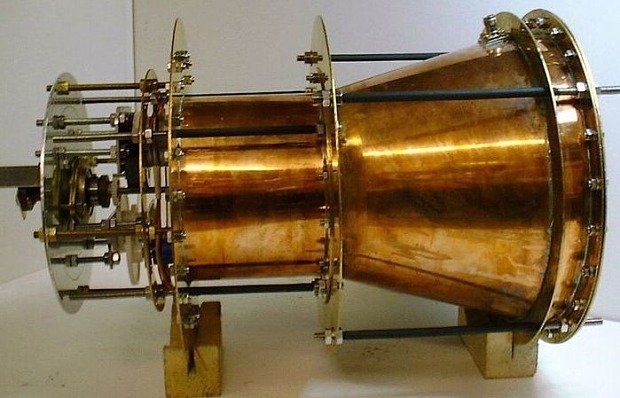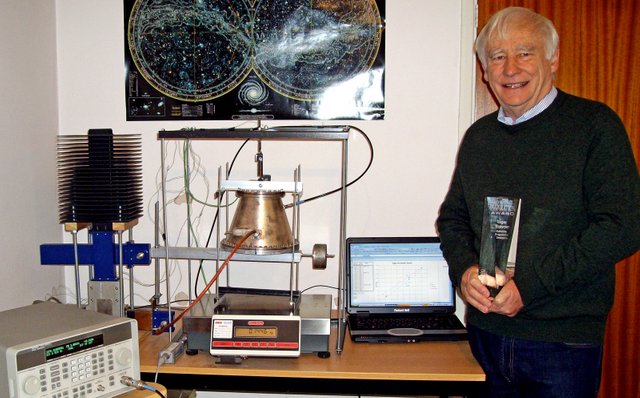Future Technologies: The EM Space Drive and How it Might Revolutionize Space Travel
I graduated from American University with a BA in International Studies in December 2015 with a regional focus on Asia and a specialty in Environmental Sustainability and Global Health. I studied abroad at National Chengchi University in Taiwan. This series on Future Technologies seeks to explore the latest breakthroughs in technology that are being made around the world and discuss their potential implications.

The Idea
Newtons 3rd law is immutable: "For every action, there is an equal and opposite reaction." This is conceived of as a fundamental law of physics. That is why, since the invention of rocketry, every rocket has utilized fuel propellant in some manner to propel itself. Rocket fuel=action, motion=opposite reaction. Consequently, the idea of an electromagnetic drive, which would require no "action" to cause "reaction", has been scoffed at as a thing of science fiction ever since it was first dreamt up.

Well, since 2001 British scientist Roger Shawyer has been claiming to have created such a drive. It replaces the traditional rocket's use of fuel with electromagnetic waves that create force by generating microwave photons in an enclosed metal cavity, pushing against the inside of the device and thus causing acceleration in the other direction.

A Debate Reignited
Over the decades, few have taken him seriously, and he has been accused of pseudoscience and lack of precision in his experiments. However, there are some who have at least been willing to consider his ideas, and they have been gaining ground in the scientific community in the past months. There a number of scientists around the world who have replicated his experiments, and achieved similar thrust.
- In 2008, a group of Chinese researchers from the Northwestern Polytechnical University took an interest in the concept and began working on a prototype, testing it multiple times between 2012 and 2014. The group noted positive results through all its experiments.
- In 2014, a group of NASA researchers tested their own prototype in a hard vacuum and once again reported thrust, although their paper was never published in a peer-reviewed journal and many researchers were skeptical.
- Last year, a test by NASA research group Eagleworks seemed to reconfirm the possibility of an EM Drive. Source
Then later that year, Shawyer's findings were independently reproduced by German scientists Martin Tajmar and co-author G. Fiedler. While they do not come to the same expansive conclusions that Shawyer does, their paper says that they also observed thrust being produced by the so-called EM Drive. They further note that many of the flaws they saw in the original experiment (which they had thought to blame for the thrust Shawyer found) could be ruled out. Ultimately, they suggest that
we do observe thrusts close to the actual predictions after eliminating many possible error sources that should warrant further investigation into the phenomena.
This is already a far cry from how scientific community was receiving these claims just 5 years ago. Furthermore, there are now rumors that a paper on the EM Drive has finally passed the peer review process and is due to be published in the American Institute of Aeronautics and Astronautics’ AIAA Journal of Propulsion and Power. Source

Implications
Such a drive would revolutionize space travel. Currently, rockets are in large part limited in speed and potential length of mission by how much rocket fuel they can carry. An electromagnetic drive could function for an indeterminably longer period of time, and Shawyer has even claimed that, according to his calculations, an EM Drive could allow for a mission to Pluto that would take less than 18 months, and a mission to Alpha Centauri (the closest neighboring galaxy) in less than 92 years. Consider that kind of speed, and then combine it with the progress SpaceX is making on rockets that can land back on Earth instead of crashing into the ocean, and cheap space travel to the moon, Mars, or even beyond starts to look more likely. To those who dare to dream, maybe the stars aren't so far after all. Source

Sources
- http://www.digitaltrends.com/cool-tech/emdrive-news-rumors/
- http://www.sciencealert.com/new-paper-claims-that-the-em-drive-doesn-t-defy-newton-s-3rd-law-after-all
- http://www.popularmechanics.com/science/energy/a22678/em-drive-cannae-cubesat-reactionless/
- http://www.ibtimes.co.uk/emdrive-could-microwave-thrusters-be-key-ending-global-energy-crisis-1459997
- http://www.wired.com/2015/05/nasa-warp-drive-yeah-still-poppycock/
- http://io9.gizmodo.com/no-german-scientists-have-not-confirmed-the-impossibl-1720573809
- http://www.wired.co.uk/article/emdrive-space-drive-pluto-mission
- http://www.sciencealert.com/the-impossible-em-drive-is-about-to-be-tested-in-space
Awaiting to see what the Cannae-Drive folks do with it. I'm skeptical EmDrive will scale, but I try to be optimistic. :) Alcubierre drive is my favourite of far-out propulsion techniques. More realistic is Starshot though - reaching Alpha Centauri in half a century is a realistic goal. At least for tiny bots...
Yeah I agree about Starshot being the most realistic, and that one can probably win a lot of popular appeal with Stephen Hawking and Yuri Milner working on it. Keeping my fingers crossed on this one though! Is there a major difference between Shawyer's prototypes and the Cannae one? Everywhere I read about it just says theyre really similar.
I have read several posts about that on steemit and yours is definitely the one I enjoyed the most! Thanks for sharing.
Thanks for reading! I enjoyed writing it. Nothing like dreaming about (highly improbable) possibilities.
Awesome post, I love reading about this stuff! The future is going to be amazing.
I had not heard this new development. Thanks for sharing. I really do hope that this pans out in the long term. We really do need a more advanced form of propulsion to drive things forward (no pun intended).
I have always had an ambition to visit Mars. The EM drive may be part of the first step on that journey even if it isn't directly responsible it could allow for new technologies using similar principles that could get us there.